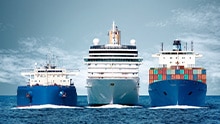Cruises remain growth drivers and the shipbuilding industry even records two-digit growth figures in view of increased Chinese market presence. At the same time, new quality standards are quickly coming into play with regard to maritime climate protection and human and machine safety on board. SICK is supporting this wave of innovation with high-quality, technological solutions.
Cruise boom continues unabated: Making cruises greener with SICK
Vacations at sea remain attractive: Passenger numbers are increasing and new cruise ships are becoming larger and larger with capacities of up to 10,000 passengers and a crew of around 2,500. In addition, the industry strongholds in the USA and Europe will be faced with increased competition as China further drives demand for cruise ships. The main reason behind this is the “China 2025” agenda, with which China has set itself the goal of becoming the global leader in the construction and operation of cruise ships. So the “Made in China” strategy no longer just applies to building container ships – with these cruise ships for the high seas, the PRC is continuing to make gains in the most complex and technically demanding area of specialty shipbuilding. Furthermore, China’s high-income middle class is growing and more and more families are choosing to spend their vacations at sea. Destinations in Asia are also of interest to European travel providers.
Many dreams come true on cruises. That is why cruises are one of the most attractive offers for tourists. In order for this to remain the case and so that their fleets can remain competitive, shipyards and ship owners are continuously perfecting their cruise ships and implementing new ideas. The need for action across the entire supply chain in the cruise industry is increasing dramatically. Just as comfort and entertainment options on board are on the rise, so too are the demands for increased efficiency and safety. On top of this, the logistics workload must be processed quicker and with more flexibility. Ever-more driverless vehicles are being used for this reason, such as in baggage logistics. These autonomously driving robots must be secured to avoid accidents. Monitoring the gas consumption of propulsion systems and reducing the CO2 footprint have become a natural part of climate protection
Making cruises greener
Now it is not only climate activists and residents around ports who are actively reacting against ship exhaust gas emissions. Passengers also want to travel with a clear conscience on clean ships. The energy revolution has already advanced a great deal on cruise ships and ship owners often anticipate legal regulations when they introduce innovations.








